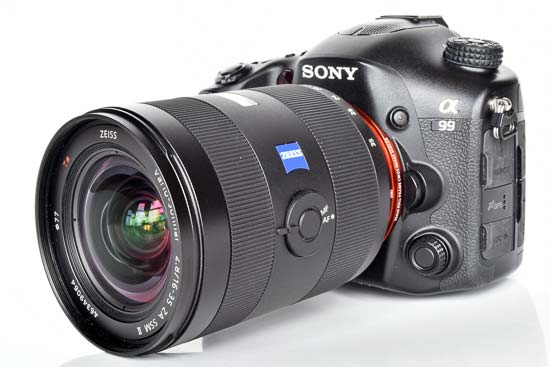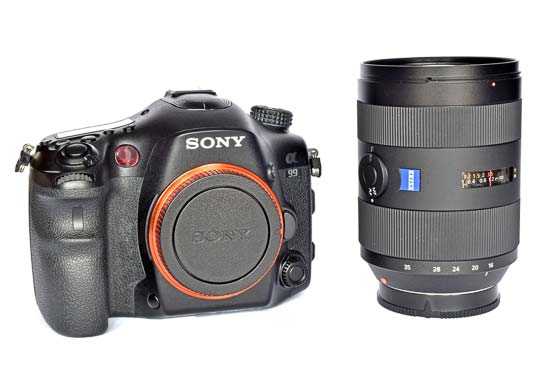Sony Vario-Sonnar T* 16-35mm F2.8 ZA SSM II Review
-
Ease
of Use -
Sample
Images -
Lens
Specs -
Rating &
Conclusion -
Main
Rivals -
Review
Roundup - Comment
-
More…

Introduction
The Sony Vario-Sonnar T* 16-35mm F2.8 ZA SSM II is an updated version of Sony’s Vario-Sonnar T* 16-35mm F2.8 ZA SSM lens and is designed for Sony Alpha 35mm full-frame and APS-C A-mount DSLT cameras. It can also be mounted on E-mount mirrorless bodies by using an LA-EA1 A-mount to E-mount adaptor.
Headline specs are identical to the previous version of this lens. You still get a constant f/2.8 maximum aperture and a nine-bladed circular diaphragm for smoother bokeh blur in out of focus areas, as well as the same 28cm minimum focus distance. The new lens also features an ED (Extra-low Dispersion) glass element and a Super ED element for improved contrast and colour accuracy, and it incorporates aspherical lens elements to help reduce chromatic aberration. Even the external casing appears almost identical.
So what’s new? Sony is claiming improved image quality with less ghosting and flare, along with 4x faster subject tracking speed from the Super Sonic wave AF motor. But the most notable new addition for this second edition 16-35mm f/2.8 ZA is that it’s now been given weather seals, making it dust and water resistant.
The Vario-Sonnar T* 16-35mm F2.8 ZA SSM II has an RRP of £2049, compared with £1729 for the original version, which at the time of writing is still on sale.
Ease of Use
At 114mm long with a maximum diameter of 83mm, the 16-35mm F2.8 ZA SSM II is identical in size to its predecessor, but marginally lighter at 872g. This is a fairly typical size for a professional-grade ultrawide zoom lens designed for a full-frame SLR-style camera, though it’ll somewhat dwarf an Alpha mirrorless camera, should you attach it to one via an adaptor.
 The Sony Vario-Sonnar T* 16-35mm F2.8 ZA SSM II lens mounted on a Sony A99
The Sony Vario-Sonnar T* 16-35mm F2.8 ZA SSM II lens mounted on a Sony A99
 The Sony Vario-Sonnar T* 16-35mm F2.8 ZA SSM II lens mounted on a Sony A99
The Sony Vario-Sonnar T* 16-35mm F2.8 ZA SSM II lens mounted on a Sony A99
 The Sony Vario-Sonnar T* 16-35mm F2.8 ZA SSM II lens mounted on a Sony A99
The Sony Vario-Sonnar T* 16-35mm F2.8 ZA SSM II lens mounted on a Sony A99
 The Sony Vario-Sonnar T* 16-35mm F2.8 ZA SSM II lens mounted on a Sony A99
The Sony Vario-Sonnar T* 16-35mm F2.8 ZA SSM II lens mounted on a Sony A99
 The Sony Vario-Sonnar T* 16-35mm F2.8 ZA SSM II lens mounted on a Sony A99
The Sony Vario-Sonnar T* 16-35mm F2.8 ZA SSM II lens mounted on a Sony A99
 The Sony Vario-Sonnar T* 16-35mm F2.8 ZA SSM II lens alongside the Sony A99
The Sony Vario-Sonnar T* 16-35mm F2.8 ZA SSM II lens alongside the Sony A99
Externally there’s little if any difference between the old and new lenses, and the 16-35mm F2.8 ZA SSM II retains the same high quality metal casing, but with added weather seals. The space available along the length of the lens barrel is well utilised with wide focussing and zoom rings, split by a focus distance window that displays the minimum .28-metre focusing distance through to infinity, along with the equivalent measurements in feet. Both the zoom and focussing rings operate as smoothly as you’d expect for a lens in this price bracket, though there are no hard stops at each end of the focussing scale.
 Front of the Sony Vario-Sonnar T* 16-35mm F2.8 ZA SSM II lens
Front of the Sony Vario-Sonnar T* 16-35mm F2.8 ZA SSM II lens
 Rear of the Sony Vario-Sonnar T* 16-35mm F2.8 ZA SSM II lens
Rear of the Sony Vario-Sonnar T* 16-35mm F2.8 ZA SSM II lens
 Side of the Sony Vario-Sonnar T* 16-35mm F2.8 ZA SSM II lens
Side of the Sony Vario-Sonnar T* 16-35mm F2.8 ZA SSM II lens
 Side of the Sony Vario-Sonnar T* 16-35mm F2.8 ZA SSM II lens at 70mm
Side of the Sony Vario-Sonnar T* 16-35mm F2.8 ZA SSM II lens at 70mm
 Side of the Sony Vario-Sonnar T* 16-35mm F2.8 ZA SSM II lens
Side of the Sony Vario-Sonnar T* 16-35mm F2.8 ZA SSM II lens
Whereas most lenses of this quality feature several switches around the lens barrel, the 16-35mm F2.8 ZA SSM II only has two controls. You won’t find any image stabilisation options, as Sony A-mount DSLT cameras have in-body stabilisation. Instead, the lens just sports a simple AF/MF switch which, though large, won’t rotate accidentally. If anything, it’s slightly too stiff for completely comfortable use. The other lens control is a focus lock button, conveniently-placed within the focus mode switch.
 Side of the Sony Vario-Sonnar T* 16-35mm F2.8 ZA SSM II lens
Side of the Sony Vario-Sonnar T* 16-35mm F2.8 ZA SSM II lens
 Side of the Sony Vario-Sonnar T* 16-35mm F2.8 ZA SSM II lens in-hand
Side of the Sony Vario-Sonnar T* 16-35mm F2.8 ZA SSM II lens in-hand
 The Sony Vario-Sonnar T* 16-35mm F2.8 ZA SSM II lens in-hand
The Sony Vario-Sonnar T* 16-35mm F2.8 ZA SSM II lens in-hand
Focal Range
The 16-35mm focal range gives an angle of view of 107-63 degrees on 35mm full frame sensor and 83-44 degrees on an APS-C camera.
Focusing
The lens’ internal Super Sonic wave motor isn’t silent, but it is quiet and unobtrusive. While there’s a dedicated manual focussing setting, instant manual focus override is available when in AF mode: just rotate the focussing ring.
The front of the lens doesn’t rotate or extend during focussing, so 77mm graduated filters can be used without issue. The front lens element does move though. It’s flush with the front edge of the lens barrel at 16mm, then retracts within the barrel by up to ¼-inch at 22mm, before extending back out to flush again at 35mm.
We found the SSM AF motor to be smooth, fast and accurate. No instances of focus hunting were experienced and tracking AF was certainly fast, though we did not have a first-generation 16-35mm F2.8 ZA SSM available for a direct speed comparison.
Chromatic Aberrations
Sony’s premium optical elements and coatings help ensure that chromatic aberration (purple fringing) is rarely an issue. Shoot a high contrast scene and there may be some slight fringing on the edges of frame, but it’s minor and unobtrusive, even when viewed at 100% like in the crops below.
 |
 |
Light Fall-off
Fall-off is usually apparent on wide-aperture ultra-wide lenses, and the 16-35mm F2.8 ZA SSM II is no exception. At 16mm wide open at f/2.8 there’s obvious vignetting that’s visible in both our test shots and in real-world photos. By f/5.6 the vignetting is less severe, but it stays visible even at narrow apertures. Only at 24mm and beyond does fall-off really subside at all apertures. Even so, correcting even the worst fall-off is easy in Photoshop, so isn’t something to be too worried about.
 Light fall-off at 16mm
Light fall-off at 16mm
 Light fall-off at 35mm
Light fall-off at 35mm
Distortion
The 16-35mm F2.8 ZA SSM II produces an impressively minor amount of barrel distortion at 16mm (fall-off is much more apparent than distortion), changing to an equally slight degree of pincushion distortion at 35mm. Unless you’re shooting geometric or architectural subjects, this level of distortion shouldn’t be too noticeable. However it is worth noting that the wide-angle barrel distortion isn’t quite uniform across the frame, making post-processing correction a little trickier than normal.
 Distortion at 16mm
Distortion at 16mm
 Distortion at 35mm
Distortion at 35mm
Macro
The large field of view captured by ultrawide lenses doesn’t make them well suited to close-up work, but a 28cm minimum focus distance is helpful if you want to get up close to a large object to accentuate its size and perspective. It’s also worth noting that 28cm refers to the distance between your subject and the camera sensor. The closest focussing distance between your subject and the front of the lens is more like 11cm, and this stays constant throughout the zoom range.
 Close-up performance
Close-up performance
Bokeh
A major appeal of fast, wide-aperture lenses is their ability to produce an eye-catching separation between a sharp subject and a soft out-of-focus background. The 16-35mm F2.8 ZA SSM II generates very smooth out of focus areas through its use of a nine-bladed diaphragm, which provides smoother bokeh than seven or five-blade designs. Bokeh is however a fairly subjective part of a lens’ image quality, so check out these 100% crops to see the 16-35mm F2.8 ZA SSM II’s bokeh quality for yourself.
 |
 |
 |
 |
Sharpness
In order to show you how sharp this lens is, we are providing 100% crops on the following pages.
-
Ease
of Use -
Sample
Images -
Lens
Specs -
Rating &
Conclusion -
Main
Rivals -
Review
Roundup - Comment
